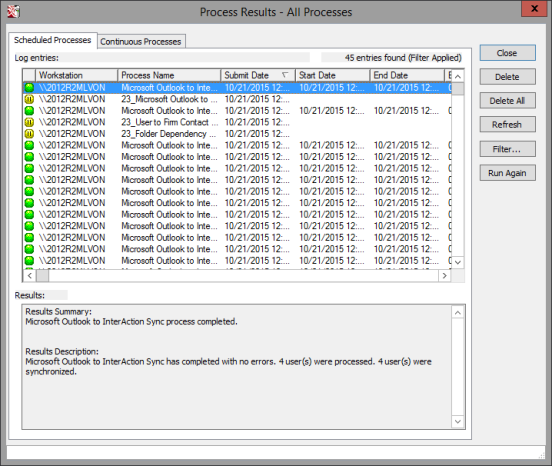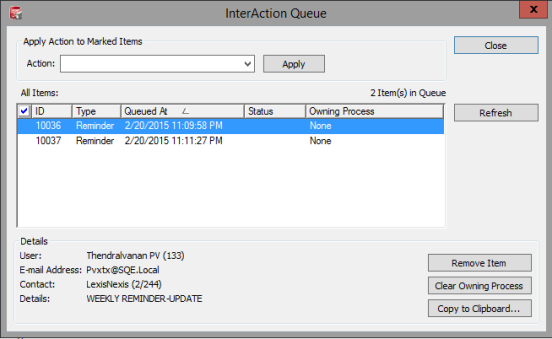Section Topics
Reviewing the Results for a Process
There are three different types of logs maintained for InterAction Process Manager, as described in the following table.
| Type | Description |
|---|---|
| Logs for each type of process |
Each type of process can maintain its own log of the changes made during the execution on the actual workstations that run the processes. For example, the log file for User to Firm Contact Sync maintains information about the user collections that were synchronized and any information that was added or changed during the synchronization. This log file is saved on the actual workstations that run the processes. For more information, see the following:
|
| Logs for the individual scheduled processes |
Each process that you schedule maintains log entries in the InterAction database about each time it is run. These log entries include basic information about the process including when the process started, when it completed, and if any errors occurred. For more information, see Logging for Processes. |
| Log for the actual Process Manager application |
This log file is saved on the actual workstations that run the processes. This file displays errors encountered by the Process Manager when attempting to run a process. For example, if Process Manager cannot connect to the database to retrieve the information about the process to be run, an error is written to this file. For more information, see Process Manager Error File. |
Logging for Processes
Each process you schedule records log information to the InterAction database about when the process ran and if it ran successfully.
You can access these logs from the Process Results dialog box. By default, only processes from the past seven days display. To see a larger range of processes, choose Filter and select the range of days from which you wish to see results.
From the Process Results dialog box, you can do the following:
- Choose Delete to delete the currently selected log entry.
- Choose Delete All to delete all log entries.
- Choose Run Again to run the process currently selected immediately.
- Choose Refresh to update the log entries for any processes that ran after the dialog box was opened.
- Choose Filter to change the range of days you want to view, the workstation, or process type.
Process Logs for Scheduled Processes
Each process log maintains the following information for scheduled processes:
- Workstation
- Process name
- Submit date
- Start date
- End date
- Results

Viewing Scheduled Process Results
Process Logs for Continuous Processes
Each process log maintains the following information for continuous processes:
- Workstation
- Process name
- Date
- Utilization %
- Items Processed
- Re-queued
- Failed
- Avg Time (min)
- Results

Viewing Continuous Process Results
Review Process Results for Processes
To view process logs:
- Double-click Process - Schedule and Results in the main window entity list of InterAction Administrator
-
Determine if you want to review an individual process or all processes.
- For individual processes, select the process you want to review from the All processes list, then choose Results.
-
For all processes, choose All Results.
The results of the currently selected process display in the Process Results dialog box.
- If you chose to review all processes, choose either the Scheduled Processes or Continuous Processes tab to view logs for the given process type.
Managing the Work Items of Continuous Processes
If all processes are properly configured and running, work items generally remain in the InterAction Queue for very short periods of time. Unless there are problems with one of the delivery processes, you should not make changes to items in the queue.
If a problem arises with a continuous process, you can manage the list of Reminder and Report work items that are in the queue from InterAction Administrator. This includes:
- Deleting work items from the queue
- Clearing the process that owns the work item from that item so it can be reassigned to another process
Note: You can only perform these actions on items that are not already in process.
You can either perform these actions on multiple work items using the Actions drop-down list or on individual work items by selecting the item and choosing either the Remove Item or Clear Owning Process button.
| Field | Description |
|---|---|
| Apply Action to Marked Items | |
| Action |
Specifies the action that is performed on all marked work items after you choose Apply. The options are:
|
| Apply | Performs the action selected in the Action drop-down list |
| All Items | |

|
Displays a check when a work item is marked |
| ID | The unique identifier of the work item |
| Type |
What kind of work item is queued, either:
|
| Queued At | The date and time the item was queued based on your regional settings |
| Status |
The state of the work item:
|
| Owning Process | The name of the continuous process that has picked up the work item in the queue. If the item does not have an owning process, None displays. |
|
Details The fields vary depending on whether the work item is a reminder or a report. |
|
| For Reminders |
|
| For Reports |
|
| Buttons | |
| Refresh | Refreshes the queue of work items. To prevent the queue from changing while you are performing tasks, there is no automatic refresh on this dialog box. |
| Remove Item | Deletes the item from the queue |
| Clear Owning Process | Clears the process that owns the work item from that item so it can be reassigned to another process |
| Copy to Clipboard | Copies the information provided in the Details section to the clipboard so you can paste it in another application. This is most helpful when working with InterAction Technical Support. |

InterAction Queue
Process Manager Error File
Any errors that occur when the Process Manager runs a process are logged to error logs. These error logs, either called IntProcessMgr.err or IAAdmin.err, are located in the Data directory of the Process Manager workstation. You can open the error log file in any text editor.
Note: Do not use an application such as Microsoft Word to open the error log while a process is running. This locks the file and the process manager application is unable to write to it. Use Notepad instead or make a copy of the log to avoid this problem.
The errors that appear in this log file include the following:
- System errors - for example, if the Process Manager cannot get information about a process. This error only occurs if your configuration of the process is not correct. The error codes vary.
- Database operation error - for example, if records cannot be retrieved or inserted into the database. The error codes vary and depend on the actual error that occurred.
- SMTP errors - for example, if you want to send email notifications and you have not set your SMTP settings in InterAction Administrator. This error code is always 1055.
Errors that occur with the process are recorded in the log for that specific scheduled process. For more information, seeLogging for Processes.
Deleting the Process Manager Error Log
By default, the IntProcessMgr.err log file automatically deletes entries older than seven days. You can change the number of days by adding the following entry to the IAAdmin.ini file on the Process Manager workstation:
[Defaults]
KeepErrorsForXDays=<Number of days>
For example, to delete entries older than three days, enter the following:
[Defaults]
KeepErrorsForXDays=3
During deployments, archive the error logs before they are deleted. The data in the logs can be very useful if you encounter any problems during the deployment. To keep the logs from growing too large, make a copy in another location, then allow the normal automatic purging.
